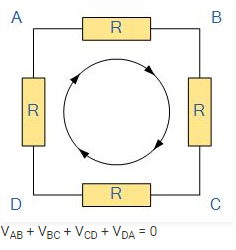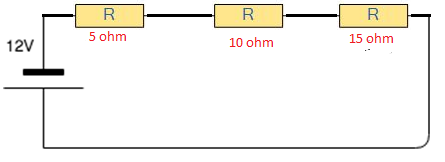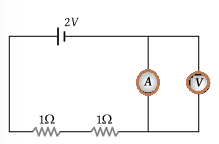Kirchhoff’s junction Law or Kirchhoff’s Current Law
The total current entering a junction or a node is equal to the charge leaving the node as no charge is lost.

Kirchhoff’s Loop Law or Kirchhoff’s Voltage Law
The voltage around a loop equals the sum of every voltage drop in the same loop for any closed network and also equals zero.

Q1: Calculate the voltage across the 5ohm resistor

- 12 V
- 2 V
- 10 V
- 0 V
Answer: (b) 2 V
Q2: Which basic law should be followed to analyse the circuit?
- Newton’s law
- Faraday’s law
- Amperes law
- Kirchoff’s law
Answer: (d) Kirchhoff’s law
Q3: Calculate the value of V1 and V2

- 4V, 6V
- 5V,6V
- 6V, 7V
- 7V, 8V
Answer: (a) 4V, 6V
Q4: In Kirchhoff’s first law Σi = 0 at the junction is based on the conservation of
- Energy
- Charge
- Momentum
- Speed
Answer: (b) Charge
Q5: In the circuit shown below what will be the reading in the voltmeter

- 2 V
- 1 V
- 0.5 V
- Zero
Answer: (d) Zero
Q6: What is the relation between currents in the figure below

- i2 = i1 + i3 + i4 +i5
- i2 – i1 = i3 – i4 +i5
- i3 +i4 =i1+i2+i5
- I1+i5 =i2+i3+i4
Answer: (a) i2 = i1 + i3 + i4 +i5
Q7: The algebraic sum of voltages around any closed path in a network is equal to
- Infinity
- 1
- 0
- Negative polarity
Answer: (c) zero
Q8: Kirchhoff’s Current Law is based on
- The charge can be accumulated at the node
- Charge cannot be accumulated at the node
- Energy is stored at the node
- Depending on the circuit charge can be accumulated at the circuit
Answer: (b) Charge cannot be accumulated at the node
Q9: The terminal potential difference will be greater than its emf when it is
- In open circuit
- Being charged
- Being charged or discharged
- Being discharged
Answer: (b) Being charged
Q10: When the cells are connected in parallel, then
- The current increases
- The current decreases
- The emf increases
- The emf decreases
Answer:(a) The current increases
Suggested articles:
- NEET Physics Syllabus
- NEET Physics Important Topics
- NEET Physics Weightage
- Physics Formulae For NEET
- NEET Physics MCQs
- How to Score 170 Plus in NEET Physics
- Last Minute Preparation Tips for NEET Physics
Comments